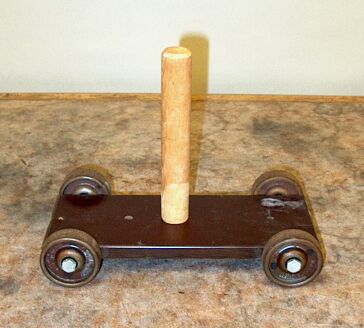
A video of this demonstration is available at this link.
This apparatus models what happens to two-liter (or one-liter) soda bottles when they are placed on the conveyor belt at the check-out stand in a grocery store. Rapidly accelerate the skate, and the dowel falls backwards. Gently accelerate the skate so that the dowel remains upright, then stop the cart, and the dowel falls forward. (Coming to a gradual stop, of course, allows the dowel to remain standing.)
In the tablecloth (12.12), screw-over-flask (12.18) and pull-bottom-from-stacked-blocks (12.24) demonstrations, you overcome friction by quickly pulling something out from under an object (or multiple objects), which stay(s) in place because of its (their) inertia. In this demonstration, however, the object’s inertia causes it to topple over when its support is accelerated quickly. Though the dowel is in what is technically stable equilibrium, the region in which it is stable is quite narrow. That is, if you displace the top of the dowel a small distance from vertical, the dowel will right itself, but the displacement necessary to topple it is still fairly small. This displacement is, of course, the distance through which the top of the dowel has to move so that a vertical line drawn from the center of mass of the dowel falls outside the base of the dowel. The center of mass is at half the height of the dowel, so the top has to move by only the diameter of the dowel for this to happen. Also, because of the dowel’s inertia, the force due to friction between the skate and the bottom of the dowel tends to rotate the dowel about its center of mass, and thus to move the bottom of the dowel out from under the center of mass, thus causing the dowel to fall over.
As noted above, when you accelerate the skate, friction, acting at the base of the dowel, exerts a torque about the dowel’s center of mass. As the dowel rotates, gravity exerts an opposing torque about the trailing edge of the bottom of the dowel, from the center of mass of the dowel, which tends to right the dowel. You can illustrate several cases:
1) If you accelerate the skate slowly, the torque about the trailing edge of the bottom of the dowel, which tends to right the dowel, is greater than or equal to the torque exerted by friction on the base of the dowel, and the dowel remains upright.
If you now stop the skate suddenly, the dowel, by its inertia, wants to keep moving in a straight line. Because of friction between the base of the dowel and the skate, however, it cannot do this. The top of the dowel keeps moving, but the bottom is kept still by friction, and the dowel falls forward.
2) If you set the dowel upright and accelerate the skate quickly, the torque due to friction at the base of the dowel greatly exceeds the torque by which gravity would restore the dowel to its upright position, and the dowel falls backwards.
3) If you set the dowel upright and accelerate the skate slowly, as noted above, the dowel stays upright. Now, if you bring the skate gradually to a stop, i.e., slowly decelerate it, friction and inertia exert a torque that would topple the dowel forward, as in example 1) above, but now the opposing torque about the leading edge of the bottom of the dowel, due to gravity acting at the dowel’s center of mass, equals or exceeds it, and the dowel again remains upright.
The brief explanation is as stated above in the comparison of this demonstration to the other inertia demonstrations. That is, whether you are accelerating the skate from a standstill or decelerating it to a stop, if you do it quickly, the dowel’s inertia causes it to resist moving with the skate. Because the dowel’s center of mass is so high relative to its diameter, it topples. If you accelerate the skate slowly, however, the dowel’s inertia does not prevent it from moving with the skate, and it stays upright.